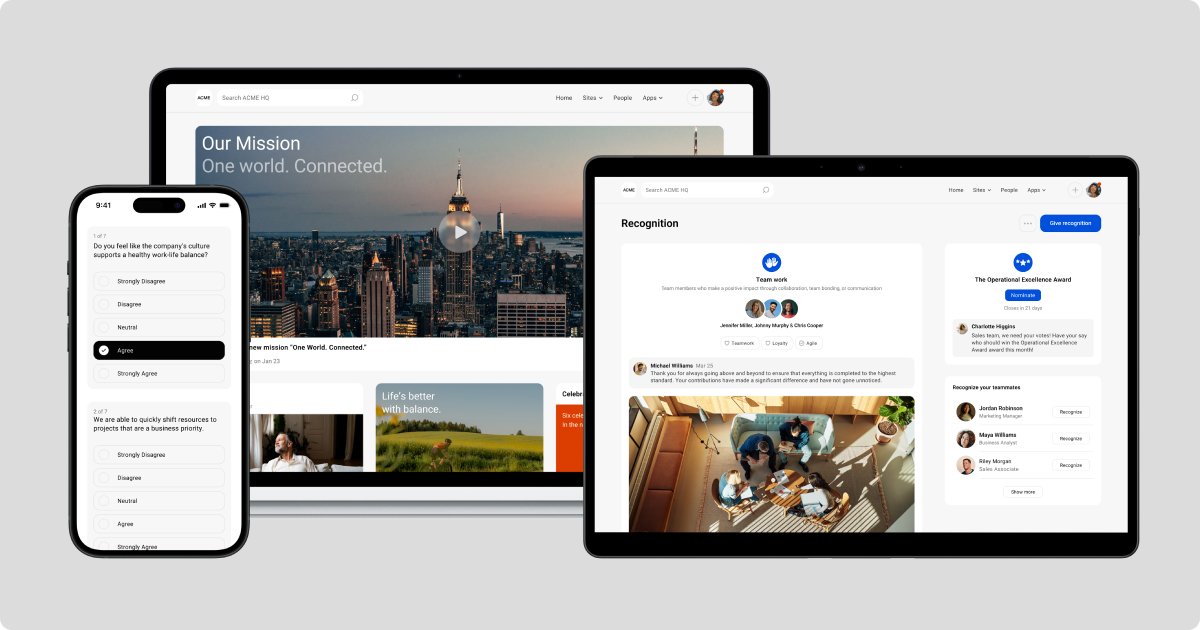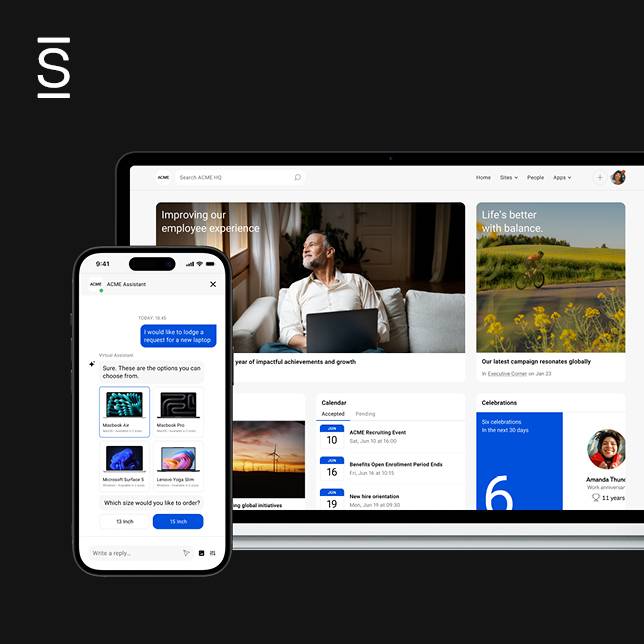Cloud-based technology has fundamentally transformed how teams work together, regardless of physical location. The right collaboration tools don't just bridge distance — they enhance creativity, streamline workflows, and eliminate friction points that slow projects down.

20 collaboration tools for extra productive teams
- 1 What is a collaboration tool?
- 2 Why internal collaboration tools matter
- 3 Best collaboration tools for teams
- 4 Meet face-to-face from anywhere
- 5 Message and collaborate effortlessly
- 6 Organize projects and track progress
- 7 Create, manage and share knowledge
- 8 Collaborate on sales and close opps faster
- 9 Design together and bring ideas to life
- 10 Simpplr: The ultimate collaboration tool
- 11 Frequently asked questions
The evolution of workplace technology and collaboration tools has been remarkable. Basic messaging and file sharing have given way to comprehensive platforms that seamlessly integrate communication, project management and document collaboration. Modern organizations need solutions that balance robust features with enterprise-grade security.
With so many options available, finding tools worth your investment can be challenging. This guide breaks down the top 20 team collaboration tools by category and explores their core benefits and limitations. Discover which ones might make the most difference to the digital employee experience at your workplace.
What is a collaboration tool?
A collaboration tool is software that enables teams to work together effectively regardless of physical location. These digital platforms facilitate cross-functional collaboration by allowing people to communicate, share information, manage projects, and coordinate their work in real time.
Modern collaboration tools typically include features like messaging, file sharing, task management, video conferencing or document editing capabilities. They help eliminate communication barriers, centralize information, and streamline workflows across departments and locations.
These tools have evolved significantly from basic email and file sharing systems to sophisticated platforms that combine multiple functions. As remote and hybrid work have become standard, collaboration software has transformed from a convenient option to essential business infrastructure.
Why internal collaboration tools matter
Remember when collaboration was limited to rooms full of people with sticky notes and whiteboards? Those days are history. Collaboration has evolved dramatically over the years. Before digital tools, teams relied entirely on in-person meetings and paper documents. Email arrived in the 1990s and revolutionized information sharing but eventually led to overflowing inboxes and version confusion.
The early 2000s brought instant messaging tools like AIM and ICQ, offering faster communication but lacking business functionality. As remote work gained momentum, platforms like Skype and Webex emerged for virtual meetings. By the 2010s, comprehensive suites like Microsoft Teams and Slack took center stage, combining messaging with productivity tools and file sharing.
Today’s busy, scattered teams need digital collaboration tools more than ever. They eliminate the dreaded “I didn’t get that email” problem, reduce meeting overload, and help work move faster.
Benefits of internal collaboration tools:
- Improved communication: Instant messaging and video conferencing strengthen team connections
- Centralized information: Consolidated documents and communications reduce information silos
- Enhanced productivity: Integrated tools minimize context switching and streamline workflows
- Flexibility and accessibility: Teams collaborate effectively regardless of physical location

Best collaboration tools for teams
With the market flooded with options, selecting the right collaboration tools requires careful consideration. To simplify your decision, we’ve categorized the top tools based on their primary function and market position.
Whether you need video conferencing solutions, project management software, messaging platforms or design collaboration tools, this guide helps navigate the most reliable and innovative options available.
Meet face-to-face from anywhere
Video conferencing tools have become essential in remote and hybrid workplaces. They enable face-to-face interaction, screen sharing and collaboration across distances. The right video conferencing tool prioritizes quality, reliability and user experience.

1. Zoom
Collaboration tool type: Video conferencing
What it’s displacing: Older video conferencing systems like GoToMeeting
How it works: Zoom delivers intuitive design alongside high-quality video and features such as breakout rooms and screen sharing. Its consistent performance makes it a preferred choice for businesses and educational institutions.
What users love:
- User-friendly interface with minimal setup
- High-quality video and audio, even with large groups
- Features like breakout rooms, conference room integration, and screen sharing
What users don’t love:
- Occasional connectivity issues during peak usage
- Security concerns reported in the past
- Frequent updates can disrupt workflows
2. Google Meet
Collaboration tool type: Video conferencing
What it’s displacing: Google Hangouts and traditional conference calls
How it works: Seamless integration with Google Workspace and secure video calls make Google Meet ideal for teams already using Google’s productivity suite. Available on desktop and mobile platforms, it adapts well to remote and hybrid work.
What users love:
- Easy integration with Google Workspace tools like Calendar and Drive
- Reliable performance for small to medium-sized meetings
- Simple interface with minimal setup requirements
What users don’t love:
- Limited advanced features compared to competitors like Zoom
- Audio and video quality varies with network conditions
- Some users find the interface less intuitive than alternatives
3. Cisco Webex
Collaboration tool type: Video conferencing
What it’s displacing: Traditional conference call systems
How it works: Webex delivers enterprise-grade video communication with advanced security features and robust integration options. Its noise reduction technology and real-time transcription enhance meeting quality while maintaining compliance with industry security standards.
What users love:
- End-to-end encryption and compliance with industry standards
- High-quality audio and video performance, even in large meetings
- Integration with popular productivity tools like Microsoft 365 and Google Workspace
What users don’t love:
- Steep learning curve for new users and admins
- Occasional connectivity issues during large-scale events
- Higher cost compared to other video conferencing solutions

Message and collaborate effortlessly
Effective internal communication tools form the foundation of successful collaboration. Messaging tools keep teams connected in real-time, facilitate updates, and maintain organized conversations. Look for platforms offering flexibility, integrations and an intuitive user experience.

4. Microsoft Teams
Collaboration tool type: Communication and video conferencing
What it’s displacing: Skype for Business, traditional email chains
How it works: Microsoft Teams integrates with Microsoft 365, offering chat, video conferencing and file sharing in one platform. Its robust security features and deep Office integration make it popular among enterprises.
What users love:
- Seamless integration with Microsoft 365 tools
- Robust security and compliance features
- Versatile collaboration through chat, video calls and file sharing
What users don’t love:
- Interface can feel cluttered and overwhelming
- Occasional slow performance with large groups
- Some features are buried under complex menus
5. Slack
Collaboration tool type: Messaging and integrations
What it’s displacing: Email, IRC-based communication
How it works: Slack organizes conversations into customizable channels for teams and projects, while supporting direct messages and threads. Its extensive integrations connect with hundreds of platforms to create a central hub for communication, files and workflows.
What users love:
- Customizable channels and workspace organization
- Simple and intuitive user interface
- Integration with hundreds of third-party apps
What users don’t love:
- Can become chaotic with too many channels
- Limited video conferencing features compared to competitors
- Notifications can overwhelm users if not managed properly
6. Google Chat
Collaboration tool type: Messaging and chat rooms
What it’s displacing: Google Hangouts, basic email threads
How it works: Integrated with Google Workspace, Google Chat enables quick communication and collaboration with easy access to other Google tools. It supports direct messaging and group conversations.
What users love:
- Seamless integration with Google Workspace, including Drive, Calendar and Meet
- Easy-to-use interface with organized chat rooms and threaded conversations
- Real-time collaboration with features like file sharing and task assignment
What users don’t love:
- Limited customization options for chat organization
- Lacks advanced features found in competitors like Slack and Microsoft Teams
- Occasional lag when handling large volumes of messages
Organize projects and track progress
Effective project management requires tools that track progress, assign tasks, and provide workflow visibility. The best project collaboration tools balance structure with flexibility, helping teams stay organized without feeling restricted.

7. Jira
Collaboration tool type: Project management and issue tracking
What it’s displacing: Manual issue tracking, spreadsheets, siloed development tools
How it works: Jira provides powerful project management with agile boards, issue tracking, and customizable workflows designed for software development and IT teams. It offers integration with various DevOps tools and allows for detailed reporting and backlog management.
What users love:
- Highly customizable workflows that fit complex processes
- Robust reporting and analytics for tracking progress and performance
- Integration with development tools like Bitbucket and Confluence
What users don’t love:
- Steep learning curve for new users
- Interface can feel overly complex for simple project management
- Configuration and setup can be time-consuming
8. Asana
Collaboration tool type: Project management
What it’s displacing: Manual task tracking and spreadsheets
How it works: Asana’s visual project boards and task assignment features simplify complex project management, offering transparency and accountability.
What users love:
- Visual project boards make tracking progress easy
- Task assignment and tracking are intuitive and transparent
- Integrates well with other productivity tools
What users don’t love:
- Interface can feel cluttered for new users
- Advanced features can be overwhelming
- Mobile app lacks some desktop functionality
9. Trello
Collaboration tool type: Project management
What it’s displacing: Sticky notes and basic task boards
How it works: Trello’s board-and-card system provides straightforward, customizable task management, ideal for visual planners and teams who prefer simple tracking.
What users love:
- Highly visual and intuitive card system
- Customizable boards for different project types
- Integration with numerous apps and services
What users don’t love:
- Limited advanced project management features
- Can become cluttered with too many cards
- Lacks comprehensive reporting capabilities
Create, manage and share knowledge
Teams regularly need to coedit documents, manage shared files, and maintain knowledge repositories. Document collaboration tools facilitate content creation while maintaining version control and accessibility.

10. Google Workspace
Collaboration tool type: Document collaboration and file sharing
What it’s displacing: Traditional file storage and document sharing methods
How it works: Google Workspace enables seamless real-time editing, integrated cloud storage, and collaboration across Docs, Sheets and Slides. Permissions allow precise control over who can view, comment or edit content while maintaining version histories.
What users love:
- Real-time collaboration with easy sharing settings
- Integration with a wide range of Google apps
- Accessibility from any device with internet access
What users don’t love:
- Can be slow with large documents or spreadsheets
- Privacy concerns related to data storage
- Limited customization compared to some competitors
11. Confluence
Collaboration tool type: Knowledge management and documentation
What it’s displacing: Traditional intranets and static documentation systems
How it works: Confluence provides a centralized space for creating, organizing and sharing content, making it ideal for project documentation and knowledge management. Teams can collaborate on pages and spaces in real time and maintain organized, searchable content.
What users love:
- Strong integration with Jira and other Atlassian products
- Real-time collaboration with version control and page history
- Powerful search functionality with metadata and tags
What users don’t love:
- Can feel overwhelming for nontechnical users
- Limited customization compared to modern intranet platforms
- Navigation can become cluttered with extensive content
12. Notion
Collaboration tool type: Knowledge management and collaboration
What it’s displacing: OneNote, traditional document management systems
How it works: Notion organizes notes, documents, databases and collaborative workspaces. Its modular building blocks allow teams to create customized knowledge systems that combine text, tables, kanban boards and embedded media in a unified platform.
What users love:
- Highly customizable workspaces and templates
- Combines note-taking, databases and task management
- Great for personal and team knowledge management
What users don’t love:
- Can be overwhelming to set up and learn
- Limited offline capabilities
- Performance issues with large databases
13. Box
Collaboration tool type: Cloud content management and collaboration
What it’s displacing: Traditional file servers and on-premises storage solutions
How it works: Box provides secure file storage, sharing and collaboration for businesses. It integrates with a wide range of productivity tools like Microsoft 365 and Google Workspace, allowing teams to collaborate on documents directly within the cloud platform.
What users love:
- Robust security features and compliance options
- Easy collaboration through shared folders and real-time commenting
- Integrates with numerous third-party applications
What users don’t love:
- Can be expensive for smaller teams
- Complex permission management for large organizations
- Occasional sync issues when dealing with large files
14. Dropbox Paper
Collaboration tool type: Document collaboration and project planning
What it’s displacing: Traditional document editors and cloud storage solutions
How it works: Dropbox Paper is an online collaborative workspace that combines document creation with task management. It integrates with Dropbox cloud storage and allows for embedding of various media types, including images, videos and code snippets.
What users love:
- Simple, intuitive interface with multimedia embedding
- Real-time collaboration and task assignment
- Easy integration with Dropbox cloud storage
What users don’t love:
- Limited offline functionality
- Lacks advanced formatting options compared to dedicated word processors
- Can feel basic for users who need more robust editing features
15. Quip
Collaboration tool type: Document collaboration and team productivity
What it’s displacing: Traditional document editing tools and email chains
How it works: Quip combines documents, spreadsheets and team chat into one platform, enabling real-time collaboration within shared workspaces. Its integration with Salesforce allows sales and service teams to create, edit and discuss documents directly from their CRM environment.
What users love:
- Real-time collaboration on documents with built-in chat
- Direct integration with Salesforce
- Simple, intuitive interface that promotes quick adoption
What users don’t love:
- Limited advanced formatting compared to standalone document editors
- Some users find the mobile app less intuitive than the desktop version
- Can be challenging to manage large numbers of documents without a clear organizational structure
Collaborate on sales and close opps faster
Sales collaboration tools connect team members throughout the customer journey. Effective sales platforms centralize prospect information, track interactions, and streamline workflows. Look for solutions that enhance visibility across the pipeline while enabling seamless handoffs between team members to accelerate deal closure.

16. Salesforce Sales Cloud
Collaboration tool type: CRM and sales management
What it’s displacing: Traditional CRM systems and manual lead tracking
How it works: Salesforce Sales Cloud helps sales teams manage leads, track opportunities, and close deals more efficiently. Built-in collaboration features like Chatter allow team members to share updates and insights directly within the platform.
What users love:
- Robust CRM features with real-time tracking and automated workflows
- Seamless integration with a wide range of business apps
- Customizable reporting and analytics
What users don’t love:
- Steep learning curve for new users
- Higher cost compared to some alternatives
- Complex customization that may require dedicated administration
17. HubSpot Sales Hub
Collaboration tool type: CRM and sales automation
What it’s displacing: Manual tracking, spreadsheets and basic CRM tools
How it works: HubSpot Sales Hub automates sales tasks like email tracking and pipeline management. Its shared inbox, notification system and permission controls allow sales teams to coordinate activities, share customer insights, and collaborate on deals without duplicating efforts.
What users love:
- User-friendly interface with clear pipeline visualization
- Automated follow-ups and email tracking
- Integration with HubSpot’s marketing and service hubs
What users don’t love:
- Limited features in the free version
- Customization options can feel restrictive
- Reporting capabilities may fall short for advanced needs
Design together and bring ideas to life
Creative teams require tools supporting real-time collaboration, visual brainstorming and design prototyping. Effective visual collaboration tools enhance creativity and enable collaborative idea refinement.

18. Figma
Collaboration tool type: Design and prototyping
What it’s displacing: Adobe XD, Sketch and traditional design collaboration tools
How it works: Figma’s cloud-based design platform enables real-time collaboration on design projects for small teams and large enterprises alike. Its browser-based interface eliminates software installation barriers while supporting commenting, version control and simultaneous editing by multiple designers.
What users love:
- Real-time collaboration and feedback features
- Intuitive interface supporting multiple stakeholders
- Seamless integration with design and prototyping tools
What users don’t love:
- Resource-intensive on older systems
- Steeper learning curve for beginners
- Occasional performance issues with complex projects
19. Miro
Collaboration tool type: Visual collaboration and online whiteboarding
What it’s displacing: Physical whiteboards, traditional brainstorming methods
How it works: Miro provides an interactive online whiteboard for teams to visualize ideas and collaborate in real-time, making it valuable for creative and strategic planning. Its extensive template library and intuitive interface support diverse workflows from agile planning to brainstorming sessions.
What users love:
- Versatile and interactive whiteboarding features
- Great for brainstorming and mind mapping
- Real-time collaboration across multiple users
What users don’t love:
- Interface can feel cluttered when many boards are open
- Occasional lag with complex or heavily populated boards
- Can be overwhelming for users unfamiliar with whiteboarding tools
20. Canva
Collaboration tool type: Design and visual content creation
What it’s displacing: Traditional graphic design software like Adobe Illustrator and Photoshop
How it works: Canva enables teams to create and collaborate on visual content like presentations, social media graphics, and documents. Its intuitive drag-and-drop editor and extensive template library make it accessible for nondesigners.
What users love:
- Easy-to-use interface with customizable templates
- Real-time collaboration for team projects
- Affordable pricing with a free tier available
What users don’t love:
- Limited advanced design features compared to professional tools
- Some templates can feel repetitive or generic
- Performance issues with large or complex projects
Simpplr: The ultimate collaboration tool
Effective collaboration keeps teams aligned and productive in today’s digital workplace. Simpplr’s EX unification platform gives dispersed workforces access to a single source of truth for people, information and resources across dispersed teams. With personalized news feeds, team spaces and analytics, employees stay connected and informed while breaking down information silos.

The platform helps teams collaborate by offering:
- Centralized communication: A single hub for news, updates and resources
- Streamlined collaboration: Dedicated spaces for team projects ensure seamless information sharing
- Easy information access: Advanced enterprise search makes finding documents quick and intuitive
- Personalized experience: Content customized to roles keeps information relevant
- Customization and extensibility: 200+ integrations out of the box and custom connectors for essential business systems
- Analytics and insights: Track engagement to improve communication strategies
Simpplr eliminates communication barriers and builds a collaborative culture regardless of employee location. By uniting people, tools and information in one platform, teams work more efficiently while staying connected and productive — making it essential for modern work environments.
Want to see how your teams can collaborate effectively with Simpplr? Request a demo today.

Watch a 5-minute demo
See how the Simpplr employee experience platform connects, engages and empowers your workforce.
- #1 Leader in the Gartner Magic Quadrant™
- 90%+ Employee adoption rate
Frequently asked questions
What types of collaboration tools do businesses need?
Most businesses need a combination of tools across several categories: video conferencing for face-to-face interaction (like Zoom or Google Meet), messaging platforms for daily communication (such as Slack or Microsoft Teams), project management software to track work (like Asana or Monday.com), document collaboration systems (such as Google Workspace or Confluence) and employee experience platforms (like Simpplr) to communicate with workers and connect them to the information and resources they need to do their job.
Which collaboration tools work best for remote teams?
Remote teams benefit most from tools that provide clear communication channels and transparency. Video conferencing solutions like Zoom, messaging platforms like Slack, employee engagement platforms like Simpplr, project management tools like Asana, and document collaboration systems like Google Workspace form the foundation of effective remote team collaboration.
How do I choose the right collaboration tools for my team?
Consider your team’s specific needs, workflow and existing systems. Evaluate tools based on ease of use, integration capabilities with your current tech stack, security features, and scalability. Start by identifying your biggest collaboration challenges and prioritize tools that address those pain points first.
Are free collaboration tools sufficient for business use?
While many collaboration tools offer free versions, businesses typically need paid plans for advanced features, better security and increased storage. Free versions of tools like Slack, Trello or Google Workspace may work for small teams or simple projects, but growing organizations usually require premium features for comprehensive collaboration needs.
How can businesses ensure adoption of new collaboration tools?
Successful adoption requires clear communication about why the tool is being implemented, comprehensive training for all users, and visible support from leadership. Start with a pilot group to identify potential issues, gather feedback on the user experience, and refine implementation plans before companywide rollout.
What security concerns should I consider with collaboration tools?
Prioritize tools with end-to-end encryption, strong authentication methods, and compliance with relevant industry regulations. Evaluate vendor security practices, data storage locations, and privacy policies. Tools like Cisco Webex and Microsoft Teams offer enterprise-grade security features that make them suitable for sensitive information.
How do collaboration tools improve productivity?
Collaboration tools eliminate information silos, reduce time spent searching for files or updates, minimize redundant work, and decrease meeting overload. They provide transparency into project status and centralize communication, allowing teams to work more efficiently regardless of location.
Can collaboration tools integrate with existing business systems?
Most modern collaboration tools offer integration capabilities with popular business applications. Look for tools that connect with your current tech stack, such as CRM systems, productivity software, and communication platforms. For example, Slack offers hundreds of app integrations, while Microsoft Teams connects with the Microsoft 365 ecosystem.
What’s the difference between collaboration tools and project management software?
While there’s overlap, collaboration tools typically focus on communication and information sharing across the organization, while project management software specializes in task assignment, tracking and workflow management. Many organizations use both: collaboration platforms for companywide communication and project tools for specific initiatives and deadlines.










